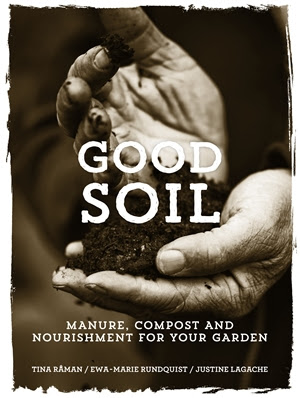I’ve spent the past few months reading about creativity in
education; for the past month one of the things that has kept me going is a big, handsome book on my bedside table. Finally, assignment submitted, I've had a chance to settle down and read about dirt. Not the latest juicy showbiz gossip, but something much more interesting and important: compost, wee, and poo of a surprising variety.

Good Soil is a fascinating book. It explores something that we gardeners know is of vital importance to our gardens but are often ignorant of - the soil and how we feed it. Without replenishment of the minerals in our soils, our gardens will fail to thrive. The authors discuss how we can help our soils by timely addition of a range of materials, such as humus-rich matter and nutrients.
The book itself is hefty and beautiful. Whilst some of the photos seem as though they are there because they are pretty (the long-horn beetle, for example), they certainly don't detract from the message. In fact, they make the book extremely 'pickuppable'. The posterior shot of a statue is a lovely subtle hint as to the content of one particular topic, though the title of the chapter is certainly less subtle! I love the discussion of the varying levels and uses of different manures; who'd have thought that the Romans prized donkey poo?
The book's authors, and so the content of the book, are based in Sweden. There are obviously a few minor differences between the UK and Sweden, for example the certificating bodies for organic status, but otherwise the information is absolutely relevant to UK (and other temperate) gardeners. The interviews with Swedish proponents of composting and lovers of soil are fascinating for the passion they reveal.
The book isn't afraid to delve into a little bit of chemistry here and there to explain how the nutrients are bound in the soil and made available to plants. I could have done with this easy to understand overview of plant nutrient deficiencies and excesses when studying for my RHS level 2 exams.
The final part of the book explores different plant groups in relation to their nutritional needs. This will be a useful guide to refer back to, as I'm rather remiss in feeding the poor shrubs in the garden. If nothing else, this book has pricked my conscience and I will be setting to with composted material and a new enthusiasm for feeding the plants and the soil fauna in the garden.
The authors write in an engaging and sometimes irreverent way, as the nature of the book often demands! It's clear that they enjoy the topic, and pass on their enthusiasm to the reader. With UK-written books obviously being the most common here, it has been really interesting to read a book from a different country, albeit with relatively similar growing conditions. It has made me think about looking for other gardening books written by non-UK authors.
Authors: Tina Raman, Ewa-Marie Rundquist, Justine Lagache.
Publishers: Frances Lincoln
Note: I was provided with a free copy to review, but all opinions are my own.